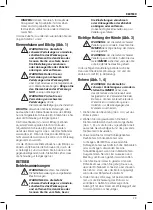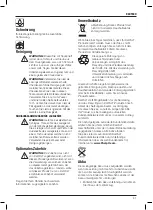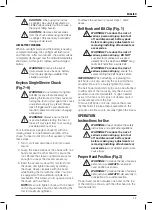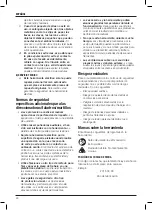
38
english
NOTE:
To ensure maximum performance and life
of lithium-ion batteries, charge the battery pack fully
before first use.
Charging Process
Refer to the table below for the charge status of the
battery pack.
Charge indicators: DCB105
charging
fully charged
hot/cold pack delay
replace battery pack
Charge indicators: DCB107, DCB112, DCB113, DCB115
charging
fully charged
hot/cold pack delay*
*DCB107, DCB112, DCB113, DCB115:
The
red light will continue to blink, but a yellow
indicator light will be illuminated during this
operation. Once the battery has reached an
appropriate temperature, the yellow light will turn
off and the charger will resume the charging
procedure.
The compatible charger(s) will not charge a faulty
battery pack. The charger will indicate faulty battery
by refusing to light or by displaying problem pack or
charger blink pattern.
NOTE:
This could also mean a problem with a
charger.
If the charger indicates a problem, take the charger
and battery pack to be tested at an authorised
service centre.
HOT/COLD PACK DELAY
When the charger detects a battery that is too hot
or too cold, it automatically starts a Hot/Cold Pack
Delay, suspending charging until the battery has
reached an appropriate temperature. The charger
then automatically switches to the pack charging
mode. This feature ensures maximum battery life.
A cold battery pack will charge at about half the
rate of a warm battery pack. The battery pack will
charge at that slower rate throughout the entire
charging cycle and will not return to maximum
charge rate even if the battery warms.
LITHIUM-ION BATTERY PACKS ONLY
XR Li-Ion tools are designed with an Electronic
Protection System that will protect the battery
against overloading, overheating or deep discharge.
in a position away from any heat source. The
charger is ventilated through slots in the top and
the bottom of the housing.
• Do not operate charger with damaged cord
or plug—
have them replaced immediately.
•
Do not operate charger if it has received
a sharp blow, been dropped, or otherwise
damaged in any way.
Take it to an authorised
service centre.
• Do not disassemble charger; take it to an
authorised service centre when service or
repair is required.
Incorrect reassembly may
result in a risk of electric shock, electrocution or
fire.
• In case of damaged power supply cord the
supply cord must be replaced immediately by
the manufacturer, its service agent or similar
qualified person to prevent any hazard.
• Disconnect the charger from the outlet
before attempting any cleaning. This will
reduce the risk of electric shock.
Removing
the battery pack will not reduce this risk.
• NEVER
attempt to connect two chargers
together.
• The charger is designed to operate on
standard 230V household electrical power.
Do not attempt to use it on any other
voltage.
This does not apply to the vehicular
charger.
SAVE THESE INSTRUCTIONS
Chargers
The DCB105, DCB107, DCB112, DCB113, and
DCB115 chargers accept 10.8 V, 14.4V and 18V
Li-Ion XR (DCB140, DCB141, DCB142, DCB143,
DCB144, DCB145, DCB180, DCB181, DCB182,
DCB183, DCB183B, DCB184, DCB184B and
DCB185) battery packs.
D
e
WALT
chargers require no adjustment and are
designed to be as easy as possible to operate.
Charging Procedure (Fig. 2)
1. Plug the charger into an appropriate outlet
before inserting battery pack.
2. Slide the battery pack (J) into the charger
ensuring that it is firmly seated and locked
in place. The red (charging) light will blink
continuously indicating that the charging
process has started.
3. The completion of charge will be indicated by
the red light remaining ON continuously. The
pack is fully charged and may be used at this
time or left in the charger.
















































